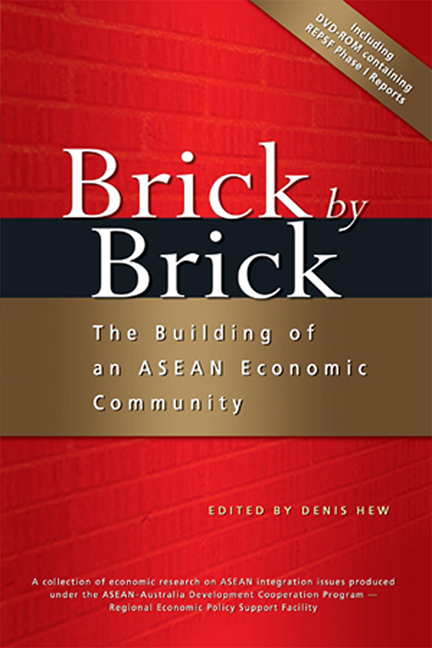Book contents
- Frontmatter
- Contents
- Foreword by Ong Keng Yong
- Foreword by Bruce Davis
- Acknowledgements by Academic Editor
- Acknowledgements by Technical Director REPSF
- The Contributors
- The Regional Economic Policy Support Facility
- 1 Introduction: Brick by Brick — The Building of an ASEAN Economic Community
- 2 What is a Single Market? An Application to the Case of ASEAN
- 3 The Challenge of Economic Integration for Transitional Economies of Southeast Asia
- 4 A Review of Regional Tariffs and Trade in the ASEAN Priority Goods Sectors
- 5 Non-tariff Barriers to Trade in the ASEAN Priority Goods Sectors
- 6 An Assessment of ASEAN's Priority Sectors for Fast-track Integration
- 7 ASEAN Tax Regimes: Impediment or Pathway to Greater Integration
- 8 An Overview of the Foreign Direct Investment Jurisprudence
- 9 ASEAN's FTA Negotiations with Dialogue Partners:Identifying Strengths and Weaknesses in Business Opportunities
- 10 Conclusion: Towards an ASEAN Economic Community by 2015
- Index
- Contents of Accompanying CD-ROM: AADCP-REPSF Phase I Research Program
The Regional Economic Policy Support Facility
Published online by Cambridge University Press: 21 October 2015
- Frontmatter
- Contents
- Foreword by Ong Keng Yong
- Foreword by Bruce Davis
- Acknowledgements by Academic Editor
- Acknowledgements by Technical Director REPSF
- The Contributors
- The Regional Economic Policy Support Facility
- 1 Introduction: Brick by Brick — The Building of an ASEAN Economic Community
- 2 What is a Single Market? An Application to the Case of ASEAN
- 3 The Challenge of Economic Integration for Transitional Economies of Southeast Asia
- 4 A Review of Regional Tariffs and Trade in the ASEAN Priority Goods Sectors
- 5 Non-tariff Barriers to Trade in the ASEAN Priority Goods Sectors
- 6 An Assessment of ASEAN's Priority Sectors for Fast-track Integration
- 7 ASEAN Tax Regimes: Impediment or Pathway to Greater Integration
- 8 An Overview of the Foreign Direct Investment Jurisprudence
- 9 ASEAN's FTA Negotiations with Dialogue Partners:Identifying Strengths and Weaknesses in Business Opportunities
- 10 Conclusion: Towards an ASEAN Economic Community by 2015
- Index
- Contents of Accompanying CD-ROM: AADCP-REPSF Phase I Research Program
Summary
This collection of studies results from the first five years of operation of the Regional Economic Policy Support Facility (REPSF), a component of the Australian Government's ASEAN–Australia Development Cooperation Program (AADCP). During this five-year period, REPSF produced a total of fifty research papers.
AADCP is the prime vehicle for the Australian Agency for International Development (AusAID) development cooperation activities carried out in collaboration with ASEAN through interaction with the ASEAN Secretariat (ASEC).
AADCP consists of three separately managed streams, namely, the Program Stream (PS), the Regional Partnership Scheme (RPS), and REPSF. The PS and the RPS implement activities of medium to small size in policy and capacity-building.
REPSF was the first stream to be mobilized in January 2002. It conducted a rolling programme of small to medium economic policy research projects. These projects assisted ASEC in its mission to provide ASEAN Working Groups with economic policy and development analysis for working towards the goal of integrating the economies of the ten ASEAN member countries (AMCs) in line with the objectives and priorities of ASEAN Vision 2020, the Hanoi Plan of Action, and the subsequent Vientiane Action Programme (VAP).
In December 2005 Australia's Foreign Minister Alexander Downer announced the funding of a further AUD5 million for joint research examining economic integration between ASEAN nations and the other East Asian nations — Japan, the Republic of Korea, China, India, New Zealand, and Australia. Therefore REPSF was given an extension period from the completion of REPSF I in January 2007 to 30 June 2008 for this East Asia Summit Research Initiative.
REPSF is a funding mechanism which, in consultation with its key stakeholders AusAID, ASEC and ASEAN's Senior Economic Officials Meeting (SEOM), provides ASEC with the capacity to develop and implement a programme of priority economic policy research. It is more specialized than the other two streams of AADCP. Its programme of economic policy research on aspects of ASEAN economic integration is undertaken by researchers selected through either competitive tender or deliberative invitation (depending on the budget level of the study). ASEC personnel and ASEAN sectoral bodies monitor the research in progress. During the project the researchers present drafts of their report to audiences of relevant ASEAN or other experts.
- Type
- Chapter
- Information
- Brick by BrickThe Building of an ASEAN Economic Community, pp. xvii - xxPublisher: ISEAS–Yusof Ishak InstitutePrint publication year: 2007

